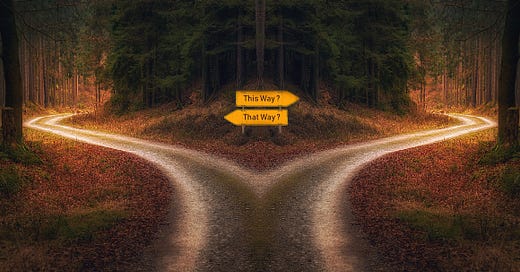Friday Forward - Reversible Decisions (#485)
We cannot expect to guess correctly dozens of times each day.
Over the past few weeks, my family has faced a lot of decisions, some due to unexpected challenges, others because of new opportunities. It’s been a reminder of just how mentally taxing decision-making can be, especially when you are juggling multiple decisions at once and have to choose quickly. This was a good reminder to tap into some conventional leadership wisdom of how we make decisions better, faster, and with more clarity about what really matters.
Sound decision making is one of the most important traits of great leaders. Some people treat every choice like a high-stakes game of chess, obsessively visualizing every possible outcome before making a move. Others focus on momentum, making good decisions quickly and repeatedly and then adjusting as needed.
Amazon founder Jeff Bezos famously categorized decisions into two types: Type 1 and Type 2. Type 1 decisions are irreversible and high impact. Once you make a Type 1 decision, there’s no going back; you may not even have the chance to course correct if you get them wrong. These choices should be made carefully and deliberately, often with data and consensus.
In contrast, Type 2 decisions are reversible, meaning that you can adjust them after the fact or even undo them entirely. In these cases, the real risk isn’t getting the decision wrong; it’s moving too slowly and missing the chance to try and learn.
The distinction between Type 1 and Type 2 decisions came to my mind recently while I listened to RJ Scaringe, Founder and CEO of Rivian, discuss how his company approaches innovation and decision-making. Rivian is at the forefront of electric vehicle design but has avoided much of the drama common to disruptors. That stability seems tied to how Scaringe makes decisions: while he is careful and cautious in Type 1 decisions, he makes Type 2 decisions as quickly as possible.
Scaringe demonstrated this mindset two years ago when Rivian announced a price increase that would impact customers who had already placed pre-orders. After immediate backlash, the company reversed the decision and honored the original pricing. This was a clear example of a leader willing to admit a mistake and walk back a decision, rather than treating it as irreversible out of fear of looking weak or foolish. That kind of humility and flexibility is a hallmark of strong leadership, but that approach is still all too rare.
This approach is also what sets agile leaders apart from those who get stuck. When you are willing to be wrong and reverse an incorrect decision, you avoid the fear of imperfection that leaves so many people unable to act fast enough. Many leaders, as well as analysts and operators, fall into analysis paralysis, obsessing over finding the perfect answer before making a move. But in most cases, the best way to learn is to decide, observe the results, and adjust as needed. This is especially true for Type 2 decisions, which make up the majority of choices in life and business, and many more than you think.
The key is not to be reckless, but to get clear on which decisions truly matter. The ones you cannot undo should be made carefully. Everything else should be approached with an emphasis on speed and learning. It is almost always better to make a justifiable decision now and refine it over time than to spend weeks chasing an impossible level of certainty.
Framing decisions this way also shifts focus away from the decision itself and toward how we implement it. Too often, we treat the moment of decision or the fork in the road as the finish line. In reality, it is just the starting point. The outcome often depends less on which path we choose and more on how well we follow through.
A single decision can lead to multiple positive outcomes depending on our execution. Life is not a constant binary of right or wrong choices. We cannot expect to guess correctly dozens of times each day. Instead, what matters more is our willingness to move forward, learn, and adjust as we go.
The challenge for many of us is not just to make better choices ourselves. It’s also to build a culture that treats reversible decisions as experiments, not final judgments. To model the humility to reverse course when a decision doesn’t work out. And to create an environment that slows down only when you truly cannot afford to be wrong.
When you do, you’ll likely move faster overall and learn a lot more along the way.
Quote of The Week
“More is lost by indecision than wrong decision.” – Marcus Tullius Cicero
Have a great weekend!
-Bob
robertglazer.com
You May Also Like:
New Article: The Most Common Company Value Mistakes
Keynotes: Book Me To Speak
New on the Elevate Podcast: Brian Scudamore on The Mistakes Every Entrepreneur Should Make




One-way door decision (Type 1) and two-way door decision (Type 2) are the names used at Amazon. Much easier to remember which one is which :)
Hi Robert, I believe making decisions in a timely matter is good advice. There's a book titled, "in the middle" or something to that effect. I realized recently that being "in the middle" too long could cause the ground underneath to turn into quick-sand. Therefore, it's best to act in a timely manner. For me, sometimes I will make a decision, so that I could realize an outcome that I hadn't thought of - some outcomes don't show themselves until the descision has been made. Then, I go slowly, so that if the new possible outcome is too negative, I still have time to reverse course if needed. I'm realizing it is best to go slower in life.